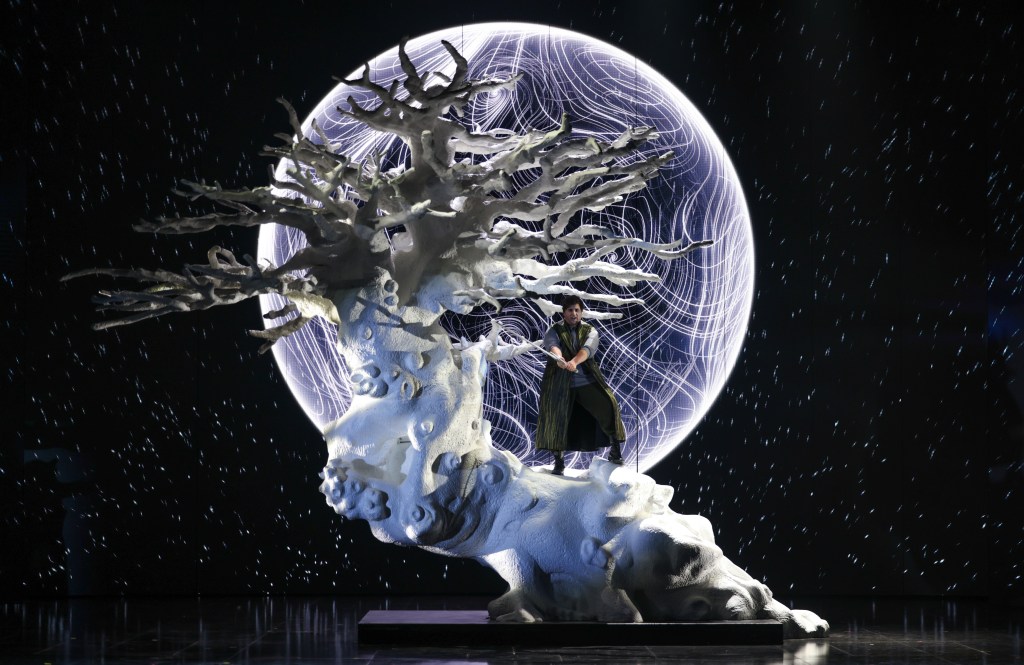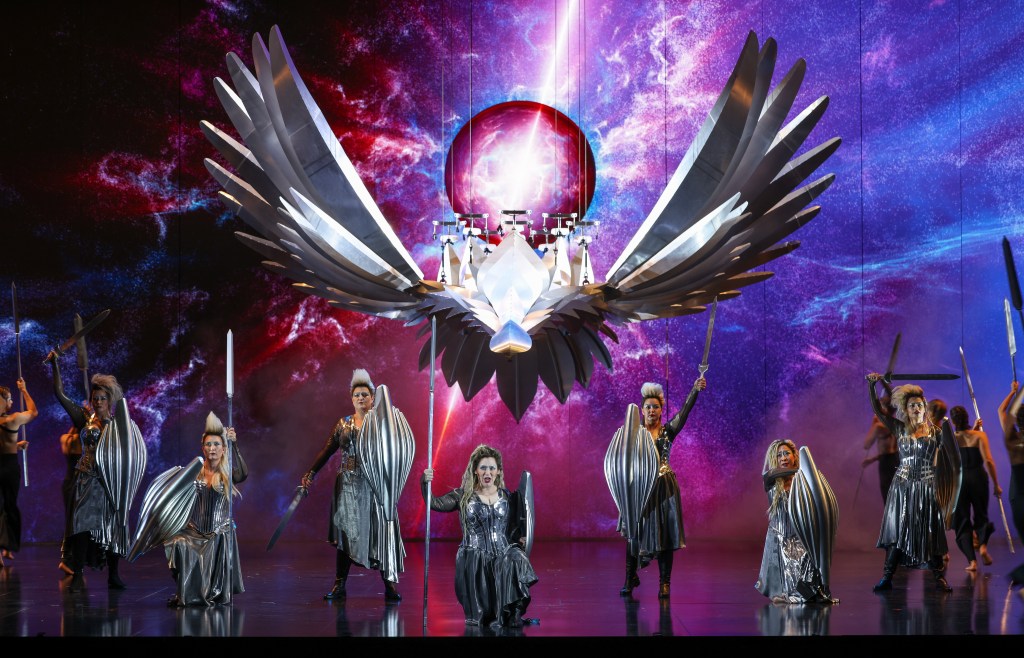The second opera in Wagner’s tetralogy of Der Ring des Nibelungen, Die Walküre is often regarded as the perfect opera. It offers some absolutely glorious music sprinkled liberally with Wagner’s leitmotifs that both introduce and impart the inner feelings of his characters. Universally heightened emotions that convey every kind of love, greed, punishment, revenge and fear are all in this score.
This third and final cycle of Opera Australia’s current season in Brisbane has seen two major cast changes, but the collective achievement of the singers both vocally and dramatically remains overwhelmingly first-rate. Anna-Louise Cole, who sang Sieglinde in the first two cycles, has replaced US superstar, Lise Lindstrom, as Brünnhilde, while Olivia Cranwell, also singing the Third Norn in Götterdämerung, has taken on the role of Sieglinde. Both were absolutely splendid in their new roles and delivered finely crafted and deeply intuitive performances alongside exceptional vocal prowess. These are clearly roles that will go into their respective repertoires in coming years.
Act I opened in similar vein to Das Rheingold, the front curtain displaying the words Die Walküre while streaming various projected translations of the title. As the orchestra commenced with a powerful thunderstorm, projected coloured shapes started to fall as the elements were unleashed. A huge tree dominated the centre stage – not the ash tree of Wagner’s creation, but a totally white bonsai, apparently captured in 3D in China’s Suzhou Gardens. It was a beautiful image, set against projected digital rain shafts, the rain falling prophetically both up and down.
At the start of the opera, Siegmund has collapsed from exhaustion. Sieglinde, his unbeknown long-lost twin sister, cares for the stranger. They are instantly attracted, constantly taking sneak peeks at one another. The arrival of the deeply unlikeable Hunding, Sieglinde’s chauvinistic husband, totally changes the dynamic.
Rosario La Spina made a near perfect Siegmund. Vocally strong through his solid tenor range, he had a powerful upper register with spine-tingling top notes. Dramatically impressive, he gave us a passionate, generous, youthful hero. A marvellous portrayal.
Olivia Cranwell’s Sieglinde was equally his match, vocally and on stage. Charming, honest and not afraid to stand up to her bullying husband, her soprano had a glorious dark timbre in the lower range with excellent high notes. Their love scenes were engrossing and totally believable. As Hunding, Andrea Silvestrelli’s black-hooded medieval-styled warrior was suitably vile, his rumbling dark bass perfect for this role, contrasting vividly with the lyrical music of the twins.
Of course, Sieglinde and Siegmund work out who they are, but it fails to stop an incestuous bond developing. In this production, their glorious love duet was played out against a pair of haunting concentric moons rising behind the tree. As the moons rotated contrary to each other, their dilemma was all too obvious. But just to egg the romantic cake, the bonsai burst into bloom with garish Chinese-styled red flowers, a rather corny image that elicited some audience groans. It was saved by the most tasteful of golden leaves flooding the stage digitally, and in reality, which was a welcome touch.
After drawing the sword, Nothung, from the tree, Siegmund and Sieglinde fled, as the golden leaves turned white and the tree a fiery red, the harbinger of things to come. This was a phenomenal ending to the first act.
In Act II Wotan, ruler of the gods, meets with his daughter, Brünnhilde, a Valkyrie warrior. Here she was dressed in shimmering silver and black with flaming red hair, spear and shield. Anna-Louise Cole was in fine form, making her Brünnhilde dramatically feisty, yet a loving and thoughtful daughter. Her powerful dramatic soprano made light of her opening famous Valkyrie calls and she was an excellent vocal match for Daniel Sumegi’s Wotan.
Wotan’s wife, the goddess of marriage Fricka, arrives to urge him to punish his own illegitimate twins for both adultery and incest.
The colourful swirling clouds that opened the act grew dark at her entry morphing into red screens that closed in around them, their colour dissolving, as Deborah Humble’s passionately sung Fricka, a fierce edge introduced to her mezzo, made her many righteous points. Worn down and through gritted teeth, Wotan agreed to abandon Siegmund.
Wotan’s subsequent scene with Brünnhilde is perhaps the most powerful in an opera, with many marvellous musical and dramatic firsts. Wotan bares his soul, telling her the story of the ring, Alberich’s curse and his own wrongdoings.
Sumegi gave a riveting and deeply moving performance, the helpless despair that he felt at what will befall the gods was at the centre of his delivery. ‘All men are freer than I am,’ he wailed, cracking with emotion, his powerful bass-baritone both commanding yet suitably weakened as the narrative unfolded. Visually the scene offered his thought processes through effective dark imagery of bubbling lights, an image of a golden ring that appeared and then started to crumble, with a final spidery web criss-crossing the screens as Wotan’s treachery was revealed.
After Brünnhilde tries to save Siegmund in his fight with Hunding, Wotan interferes by breaking the sword, Nothung, and our hero dies at the end of Act II.

Act III commenced with Wotan angrily pursuing his daughter, but not before we witnessed the famous ‘Ride of the Valkyries’, as popular in pop culture as it is in the classical music genre. Here director Chen Shi-Zheng and his team’s piece de resistance was the creation of a flying steed lowered from the fly tower and accommodating the eight Valkyrie sisters. Shaped as a large phoenix-inspired creature, this shiny metal space-age vehicle was visually impressive, even if it only moved simply up and down. Aerial flying may have been welcome here.
Dancers writhed around underneath holding spears, while the screens scudded with storm-clouds, later producing a psychedelic rainbow sky. The individual characteristics of each of the Valkyries were as recognisable as their ‘Hojotohos’ and ‘Heiahas’ and made a fine impression. The orchestra was measured in its playing and rightly so, as visually the stage seemed overly busy with much activity. The digital imagery seemed to work best when it was clean, simple and not over-explanatory.
Wotan’s banishing of the disgraced Brunnhilde was well-managed. As Wotan’s anger subsides and he offers an olive branch to his beloved daughter, the inclusion of a tearful farewell and hugs was tenderly managed by both singers and highly effective emotionally. Anna-Louise Cole’s Brünnhilde was exquisitely played in these last scenes, where her character was by turns puzzled, loving, fearful and anguished. Both dramatically and vocally, she gave a totally truthful reading of the work, no mean achievement for her first Brünnhilde.
The final scene included a night sky lit up with cloud effects that turned red and a centre stage rock that was encircled by a metallic dragon complete with smoking head, which burst into flames. Designed to protect Brünnhilde from her predators while she sleeps, this was a brilliant bit of staging. It was a terrific ending, and possibly had even more impact than the ‘Ride of the Valkyries’.
Read: Opera review: Das Rheingold (The Ring Cycle), QPAC
The Queensland Symphony Orchestra played this score magnificently, highlighting exceptionally well the leitmotifs represented by horns, woodwind and many orchestral solos. Conductor, Philippe Auguin, kept the orchestra tight, allowing them to soar and breathe in the lyrical passages, while playing powerfully and with full force in the tempestuous sections. His measured approach to conducting these four operas, without giving away everything at once, has been both intelligent and commendable. We are eager to hear more.
Die Walküre (First day, music drama in three acts)
by Richard Wagner, with libretto by the composer
QPAC
Conductor: Philippe Auguin
Director: Chen Shi-Zheng
Associate Set Designer: Maruti Evans
Digital Content Designer: Leigh Sachwitz, flora&faunavisions
Interactive Content Design and Programming: flora&faunavisions
Costume Designer: Anita Yavich
Lighting Designer: Matthew Marshall
Choreographer: Akasa Ruthy Inchaustegui
Cast: Rosario La Spina, Olivia Cranwell, Andrea Silvestrelli, Daniel Sumegi, Anna-Louise Cole, Deborah Humble, Jane Ede, Dominica Matthews, Jennifer Black, Deborah Humble, Mariana Hong, Agnes Sarkis, Angela Hogan, Ruth Strutt
Opera Australia Dancers, DanceNorth Australia, Queensland Symphony Orchestra
Die Walküre was performed 3, 10 and 17 December 2023.





